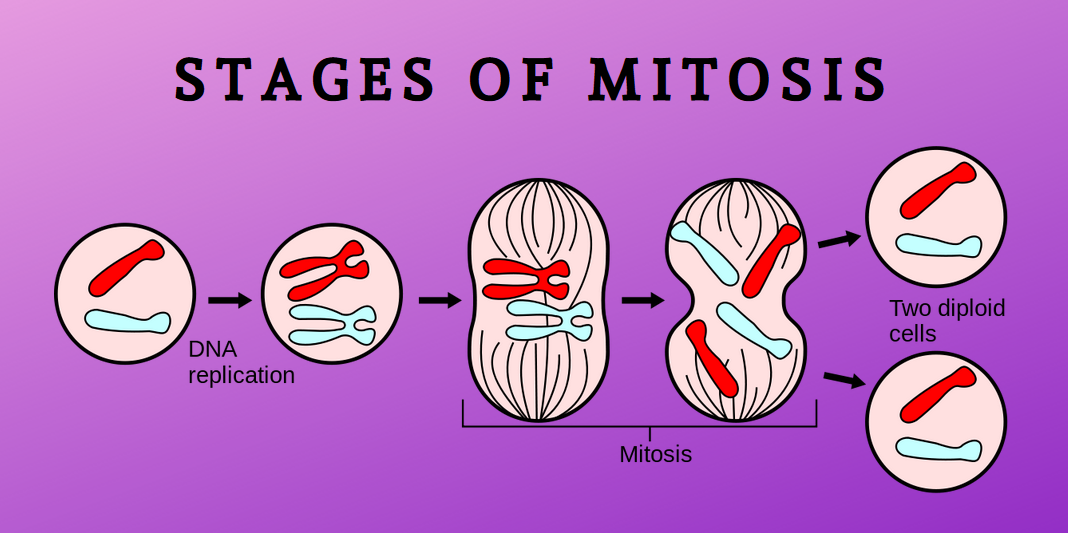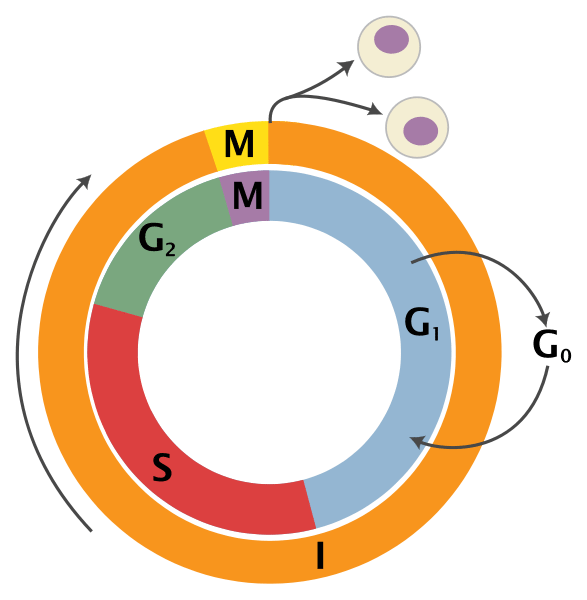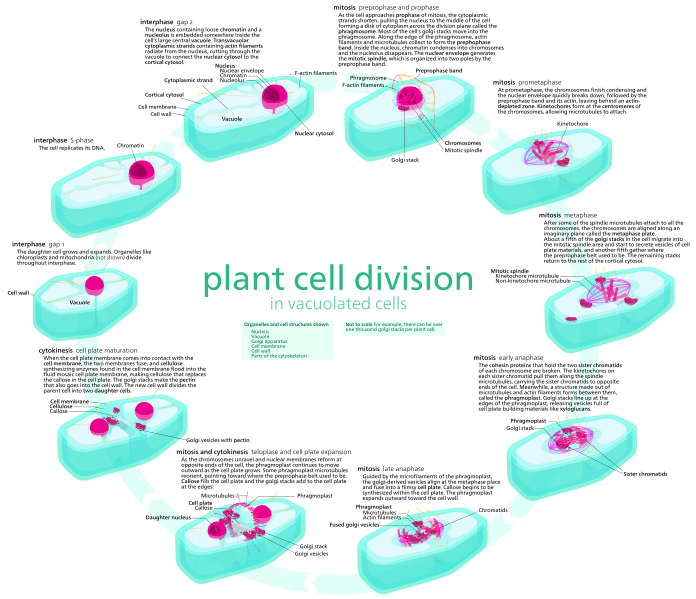
Mitosis is the process that allows cells to reproduce and copy themselves, by copying the DNA of the cell and creating two separate sets of chromosomes. How exactly does mitosis function to make two separate yet identical cells? Scientists divide mitosis into four or five different mitosis phases: prophase, metaphase, anaphase, and telophase. Each phase of the process sees critical actions carried out that are necessary for cell replication and division.
But first, here are the stages of mitosis:
- prophase
- prometaphase
- metaphase
- anaphase
- telophase
What Is The Exact Function Of Mitosis?
Mitosis comes into play when one cell, the mother cell, is going to divide to create another cell. The second cell, the daughter cell, must somehow receive a copy of the mother cell’s DNA, including all the chromosomes within the cell. If something were to go wrong and the daughter cell did not receive all the chromosomes, it can either die off or cause cancer. This is why it is so important to carry out the replication of chromosomes perfectly, and mitosis allows for this complex task to happen.

The cell cycle: I = Interphase, M = Mitosis; G1 = Gap 1, G2 = Gap 2, S = Synthesis. Photo: By Richard Wheeler (Zephyris) 2006 via Wikimedia Commons, CC-BY-SA 3.0
The Distinction Between Mitosis and Meiosis
Mitosis is often confused with meiosis, but while the two processes are similar in some ways, they are distinct in others. The primary difference in that meiosis occurs only in sex cells (gametes), the cells that are responsible for sexual reproduction. While mitosis creates an exact copy of the parent cell, meiosis creates new combinations of genes using DNA from both sperm and egg cells.
Other differences between mitosis and meiosis include the fact that meiosis creates four daughter cells, instead of two, with each cell containing only one-half the number of chromosomes and the original cell. Furthermore, the cells divide twice in meiosis, instead of only once.
The Phases of Mitosis
“The essential thing is to recognize that consciousness is a biological process like digestion, lactation, photosynthesis, or mitosis.” — Ray Kurzweil
Mitosis is usually divided into four phases: prophase, metaphase, anaphase, and telophase. Due to its long length, sometimes prophase is broken into two phases distinct phases: prophase and prometaphase. However, the actions involved in the four phases always, and by necessity, come in a specific order. Prophase and metaphase basically set up the mother cell for the division, while the actual cell division process begins in anaphase or telophase.
Before entering prophase a cell will already have created a copy of its DNA. At this point, the nucleus of the cell contains sister chromatids, two copies of the chromosomes which are connected. The cells of animals have already created a copy of its centrosome by this point. The centrosome plays an important role in mitosis, acting as organization centers of microtubules and pulling apart the chromosomes when cell division happens.
Prophase
The first half of prophase sees the cell prepare for division by setting up certain organelles and structures. The chromosomes within the nucleus begin to condense. The chromosomes are usually long and string-like, but by coiling up they can be more easily moved around the cell. The function of chromosome condensing is that the chromosomes become easier to divide later on in the cell division process. In addition, the cell forms the mitotic spindle. The mitotic spindle is made out of microtubules in between the two centrosomes, and the spindle will organize the chromosomes during mitotic division. The spindle is stretchy and it will widen as the centrosomes move farther apart from one another.
Not only does the cell create certain structures during prophase, but it also breaks down structures. The nucleolus, which is responsible for creating ribosomes, usually sits within the nucleus of the cell. However, prophase will have the nucleolus disappear as the cell gets ready for division.
In the second half of prophase (AKA prometaphase) the nuclear envelope surrounding the nucleus breaks down. This releases the chromosomes into the cell’s cytoplasm. The mitotic spindle that exists between the centrosomes will then expand and start capturing the chromosomes. By now the chromosomes are nicely compacted because they have finished condensing. The microtubules in the spindle capture the chromosomes by binding to them at the kinetochore. The kinetochore is a structure found on the centromere of the sister chromatids, the region where the chromatids are the most tightly bonded.

Photo: Kelvinsong via Wikimedia Commons, CC-BY-SA 3.0
Metaphase
By the time metaphase begins the mitotic spindle has already bonded with the chromosomes and has organized them into a line in the middle of the cell. The chromosomes are now ready for division. The two kinetochores on each chromosome should be anchored to the microtubules found on opposite sides of the cell. This is necessary for the cell to properly divide, and the cell now double-checks to make sure this is the case.
The cell undergoes a process called the spindle checkpoint, where it tests to make sure that the sister chromatids will divide down the middle as they are supposed to. If the sister chromatids are misaligned or improperly attached, the cell division will not proceed any further. The cell division will pause until the problem can be fixed and the chromosomes properly aligned for the division.
Anaphase
After the chromatids have aligned at the center of the cell, they rest on the metaphase plate. Anaphase starts when the two centrosomes begin to pull on the chromatids. During anaphase, the sister chromatids are finally pulled apart from each other at the centromere by the mitotic spindle and centrosomes. They form separate daughter chromosomes. The daughter chromosomes then migrate to opposite sides of the cells, pulled by the spindle.
The microtubules that aren’t actively pulling the chromosomes begin to elongate during this phase. This starts to push the cell apart, separating the poles from each other and making the entire cell longer as a result.
Telophase
Telophase is the final phase of cell division. After the cell is almost finished dividing itself, the halves of the cell that will become their own separate cells begin to start re-establishing the regular cell structures.
The mitotic spindle breaks down into its constituent parts, and the chromosomes unwind into their regular string-like form, reversing what happened in prophase. In addition, two nuclei are created, one for each of the cells. The nuclear membranes reform, along with new nucleoli. Yet the cell isn’t officially two distinct cells until the process known as cytokinesis completes.
Cytokinesis
Cytokinesis is the process that actually divides the cells into two new cells. It can occur in either anaphase or in telophase, as it depends on the type of cell. Animals cells divide by pinching the cytoplasm, creating a cleavage furrow, until the cytoplasm has completely divided. Plant cells cannot use this method of division, due to the fact that their cell wall makes them too rigid. Instead plant cells simply create a new cell wall, or cell plate, down the center of the cell.
The four phases of mitosis are all integral to cell division and replication. Without mitosis, the cells in your body could not replicate, and life as we know it wouldn’t exist.









